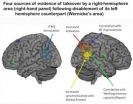(Press-News.org) PITTSBURGH—For the first time, scientists at Carnegie Mellon University's Center for Cognitive Brain Imaging (CCBI) have used a new combination of neural imaging methods to discover exactly how the human brain adapts to injury. The research, published in Cerebral Cortex, shows that when one brain area loses functionality, a "back-up" team of secondary brain areas immediately activates, replacing not only the unavailable area but also its confederates.
"The human brain has a remarkable ability to adapt to various types of trauma, such as traumatic brain injury and stroke, making it possible for people to continue functioning after key brain areas have been damaged," said Marcel Just, the D. O. Hebb Professor of Psychology at CMU and CCBI director. "It is now clear how the brain can naturally rebound from injuries and gives us indications of how individuals can train their brains to be prepared for easier recovery. The secret is to develop alternative thinking styles, the way a switch-hitter develops alternative batting styles. Then, if a muscle in one arm is injured, they can use the batting style that relies more on the uninjured arm."
For the study, Just, Robert Mason, senior research psychologist at CMU, and Chantel Prat, assistant professor of psychology at the University of Washington, used functional magnetic resonance imaging (fMRI) to study precisely how the brains of 16 healthy adults adapted to the temporary incapacitation of the Wernicke area, the brain's key region involved in language comprehension. They applied Transcranial Magnetic Stimulation (TMS) in the middle of the fMRI scan to temporarily disable the Wernicke area in the participants' brains. The participants, while in the MRI scanner, were performing a sentence comprehension task before, during and after the TMS was applied. Normally, the Wernickearea is a major player in sentence comprehension.
The research team used the fMRI scans to measure how the brain activity changed immediately following stimulation to the Wernicke area. The results showed that as the brain function in the Wernicke area decreased following the application of TMS, a "back-up" team of secondary brain areas immediately became activated and coordinated, allowing the individual's thought process to continue with no decrease in comprehension performance.
The brain's back-up team consisted of three types of brain regions: (1) contralateral areas—areas that are in the mirror-image location of the brain; (2) areas that are right next to the impaired area; and (3) a frontal executive area.
"The first two types of back-up areas have similar brain capabilities as the impaired Wernicke area, although they are less efficient at the capability," Just said. "The third area plays a strategic role as in responding to the initial impairment and recruiting back-up areas with similar capabilities."
Additionally, the research showed that impairing the Wernicke area also negatively affected the cortical partners with which the Wernicke area had been working. "Thinking is a network function," Just explained. "When a key node of a network is impaired, the network that is closely collaborating with the impaired node is also impaired. People do their thinking with groups of brain areas, not with single brain areas."
Mason, the study's lead author, noted that following the TMS, the impaired area and its partners gradually returned to their previous levels of coordinated activity, while the back-up team of brain areas was still in place. "This means, that for some period of time, there were two cortical teams operating simultaneously, explaining why performance is sometimes improved by TMS," he said.
This research builds on Just's previous research on brain resilience after stroke and brain training to remediate dyslexia. The studies are motivated by a computational theory, called 4CAPS, that provides an account of how autonomous brain systems dynamically self-organize themselves in response to changing circumstances, which the researchers believe to be the basis of fluid intelligence.
Just, who uses brain imaging to understand how brain processes underpin various types of human thought, has helped to establish Carnegie Mellon as a world leader in brain sciences. The university recently launched a Brain, Mind and Learning initiative to build from its research excellence in psychology, computer science and computation to continue to solve real-world problems.
INFORMATION:
New Carnegie Mellon research reveals exactly how the human brain adapts to injury
Findings also illustrate how individuals can train their brains to handle injuries more efficiently
2013-01-16
ELSE PRESS RELEASES FROM THIS DATE:
Study examines link between incarceration and psychiatric disorders
2013-01-16
WASHINGTON, DC, January 16, 2013 — Psychiatric disorders are prevalent among current and former inmates of correctional institutions, but what has been less clear is whether incarceration causes these disorders or, alternatively, whether inmates have these problems before they enter prison. A study co-authored by Jason Schnittker, an associate professor of sociology at the University of Pennsylvania, shows that many of the most common psychiatric disorders found among former inmates, including impulse control disorders, emerge in childhood and adolescence and, therefore, ...
Vaccination responsible for dramatic fall in Salmonella infections
2013-01-16
Mass poultry vaccination programmes introduced to combat Salmonella infections have led to a dramatic fall in the number of cases since the late 1990s, according to a researcher at the University of Liverpool.
Salmonella are important food-borne pathogens worldwide, causing diarrhoea, vomiting, nausea, fever and abdominal pain. There are currently around 6 million cases of illness from Salmonella across the EU each year, the majority of which are linked to food items such as eggs, chicken, beef, pork, salad vegetables and dairy products.
Between 1981 and 1991, the ...
Genetics plays major role in victimization in elementary school
2013-01-16
This press release is available in French.
Quebec City, January 16, 2013—Genetics plays a major role in peer rejection and victimization in early elementary school, according to a study recently published on the website of the journal Child Development by a team directed by Dr. Michel Boivin, a research professor at Université Laval's School of Psychology.
To come to this conclusion, Boivin and his team tested over 800 twins at three time points: when they were in kindergarten, Grade 1, and Grade 4. This sample consisted of 41% monozygotic twins—"true" twins who share ...
Breast cancer mortality has not declined in women over 85
2013-01-16
Since 1992 the number of deaths linked to breast cancer in Spain has decreased among young and middle aged patients but not among the elderly. Spanish researchers also predict that it will continue to decline over the next decade, although more slowly as observed up until now.
A new study headed by a team of Spanish researchers has analysed breast cancer mortality in Spain among different age groups from 1981 to 2007, setting a valid prediction up until 2023.
Studying this age-related tendency is interesting because any improvement could have significant social and ...
Paging Dr. Charles Dickens!
2013-01-16
Charles Dickens' tales are filled with immortal characters — think of A Christmas Carol's Scrooge and Great Expectations' Miss Havisham. But more than whims of literary invention, his characters and plots often deal with the difficult social realities of Victorian England. His portrayal of the disabled — both in terms of medicine and the social discrimination they faced — is no exception.
"Social attitudes towards the disabled can often be traced through art, from ancient times through today," explains Prof. Avi Ohry of Tel Aviv University's Sackler Faculty of Medicine, ...
Computational methods reveal how hospital-acquired bacteria spread
2013-01-16
Scientists at the Academy of Finland's Centre of Excellence in Computational Inference Research have developed novel computational methods that have yielded essential knowledge of how hospital-acquired bacteria spread and develop. These new methods, based on randomised algorithms, make it possible to analyse extensive genomic data significantly faster and more efficiently than previously. By applying these results, it is possible to better follow hospital-acquired infections in the future, or even fight them in real time.
The new methods are used to develop models of ...
New UMass Amherst research shows fishways have not helped fish
2013-01-16
AMHERST, Mass. – Despite modern designs intended to allow migratory fish to pass, hydropower dams on major Northeast U.S. waterways, including the Merrimack and Connecticut rivers, have failed to let economically important species such as salmon, shad and river herring reach their spawning grounds, say a team of economists and fish ecologists including Adrian Jordaan of the University of Massachusetts Amherst.
This raises serious questions about the impact of new dams now being planned and constructed on major waterways worldwide, say the researchers in the current ...
Engineer making rechargeable batteries with layered nanomaterials
2013-01-16
MANHATTAN, Kan. -- A Kansas State University researcher is developing more efficient ways to save costs, time and energy when creating nanomaterials and lithium-ion batteries.
Gurpreet Singh, assistant professor of mechanical and nuclear engineering, and his research team have published two recent articles on newer, cheaper and faster methods for creating nanomaterials that can be used for lithium-ion batteries. In the past year, Singh has published eight articles -- five of which involve lithium-ion battery research.
"We are exploring new methods for quick and cost-effective ...
U of T and Harvard study finds growing 'weight extremes' in the developing world
2013-01-16
Obese and overweight people are gaining weight rapidly in low-and middle-income countries while those who are severely undernourished are not experiencing similar weight gains, according to a University of Toronto and Harvard School of Public Health study.
This growing divide may force governments in the developing world to care for people who fall dramatically short on their calorie intake while simultaneously treating health problems associated with obesity, including diabetes and heart disease.
"One might think that as a country grows economically, the majority of ...
Study finds a new culprit for epileptic seizures
2013-01-16
CAMBRIGDE, MA -- Epileptic seizures occur when neurons in the brain become excessively active. However, a new study from MIT neuroscientists suggests that some seizures may originate in non-neuronal cells known as glia, which were long believed to play a mere supporting role in brain function.
In a study of fruit flies, the researchers identified a glial-cell mutation that makes the flies much more prone to epileptic seizures. Mutations in the gene, which influences glial cells' communication with neurons, appear to make neurons much more excitable. That excitability ...
LAST 30 PRESS RELEASES:
Tracing the quick synthesis of an industrially important catalyst
New software sheds light on cancer’s hidden genetic networks
UT Health San Antonio awarded $3 million in CPRIT grants to bolster cancer research and prevention efforts in South Texas
Third symposium spotlights global challenge of new contaminants in China’s fight against pollution
From straw to soil harmony: International team reveals how biochar supercharges carbon-smart farming
Myeloma: How AI is redrawing the map of cancer care
Manhattan E. Charurat, Ph.D., MHS invested as the Homer and Martha Gudelsky Distinguished Professor in Medicine at the University of Maryland School of Medicine
Insilico Medicine’s Pharma.AI Q4 Winter Launch Recap: Revolutionizing drug discovery with cutting-edge AI innovations, accelerating the path to pharmaceutical superintelligence
Nanoplastics have diet-dependent impacts on digestive system health
Brain neuron death occurs throughout life and increases with age, a natural human protein drug may halt neuron death in Alzheimer’s disease
SPIE and CLP announce the recipients of the 2025 Advanced Photonics Young Innovator Award
Lessons from the Caldor Fire’s Christmas Valley ‘Miracle’
Ant societies rose by trading individual protection for collective power
Research reveals how ancient viral DNA shapes early embryonic development
A molecular gatekeeper that controls protein synthesis
New ‘cloaking device’ concept to shield sensitive tech from magnetic fields
Researchers show impact of mountain building and climate change on alpine biodiversity
Study models the transition from Neanderthals to modern humans in Europe
University of Phoenix College of Doctoral Studies releases white paper on AI-driven skilling to reduce burnout and restore worker autonomy
AIs fail at the game of visual “telephone”
The levers for a sustainable food system
Potential changes in US homelessness by ending federal support for housing first programs
Vulnerability of large language models to prompt injection when providing medical advice
Researchers develop new system for high-energy-density, long-life, multi-electron transfer bromine-based flow batteries
Ending federal support for housing first programs could increase U.S. homelessness by 5% in one year, new JAMA study finds
New research uncovers molecular ‘safety switch’ shielding cancers from immune attack
Bacteria resisting viral infection can still sink carbon to ocean floor
Younger biological age may increase depression risk in older women during COVID-19
Bharat Innovates 2026 National Basecamp Showcases India’s Most Promising Deep-Tech Ventures
Here’s what determines whether your income level rises or falls
[Press-News.org] New Carnegie Mellon research reveals exactly how the human brain adapts to injuryFindings also illustrate how individuals can train their brains to handle injuries more efficiently


